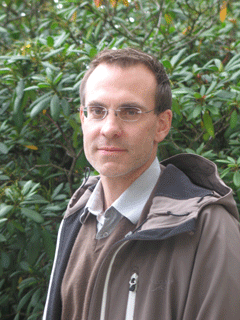Arctic Methane
Air Date: Week of October 10, 2008

The ship Yakov Smirnitskii. (Photo: Martin Krus, Stockholm University)
The Siberian coast is largely uncharted territory, but an international team of scientists traveled the Russian waters in search of methane – a potent greenhouse gas – that is welling up from permafrost beneath the arctic waves. Host Bruce Gellerman speaks with head researcher Professor Orjan Gustafsson, of Stockholm University, about the team’s findings.
Transcript
GELLERMAN: It's Living on Earth. I'm Bruce Gellerman.
Russian and Swedish scientists have found places in the Arctic Sea where huge amounts of methane are venting up from the ocean basin. Methane is a powerful greenhouse gas, and the unexpected discovery is causing concern among some scientists who fear it might speed up global warming. Professor Orjan Gustafsson at Stockholm University recently returned from an expedition which found the methane, and he joins me by phone from Stockholm. Welcome Professor!
GUSTAFSSON: Thank you.
GELLERMAN: WhereÂ’s the methane coming from?
GUSTAFSSON: Methane in the water on the East Siberian Artic Shelf is coming from sub-sea permafrost. This sea bottom used to be on land in the last ice age, and then was basically peat, that was frozen, permafrosted. And then the deglaciation—when it got warmer, the climate, then the sea levels was rising and the frozen peat was flooded. And it holds a large amount of methane. The conventional thought has been that this has been capped by the permafrost and held in place, but high levels of methane is now found in the seawater.
GELLERMAN: What would be causing this?

Örjan Gustafsson. (Photo: Linda Carlsson, Stockholm University)
GUSTAFSSON: There are three different mechanisms whereby this permafrost could be thawing. First one is geothermal heat flux. Basically, cracks in the Earth’s crust where heat from Earth’s interior is pushing up and thawing the permafrost. Another mechanism is basically when the sea level’s rising and sea water’s flooding over this land, then the sea water itself which might hold plus two degrees Celsius or so at sea bottom is providing heat to slowly thaw the permafrost. And final key mechanism is likely because of plumes of the very large Russian artic rivers that is pushing out warmer river water on the shelf—is also providing heat to thaw the permafrost.
GELLERMAN: How big is this area that this is happening?
GUSTAFSSON: The East Siberian Artic Shelf is the worldÂ’s largest continental shelf, and it covers about 50 percent of the total Artic Ocean. We donÂ’t know exactly how much methane is actually being released. What we found during the expedition is that in five or six regions, each of the area of tens of thousands of square kilometers, methane concentrations in sea water was found to be about a hundred times higher than the background methane levels in sea water. We just came back ten days ago from the expedition, and we now need to look at the full data set to evaluate what the total methane in the water column is and how quickly that might be fluxing out to the atmosphere.
GELLERMAN: Can you see the bubbles coming up out of the water?
GUSTAFSSON: You cannot see them by naked eye. I tried actually. I stepped out on the deck to try to see if I could see them by naked eye—these bubbles. I could not. But you can see them with our geophysical instrumentation.
GELLERMAN: What do we make of your findings so far?

The ship Yakov Smirnitskii. (Photo: Martin Kruså, Stockholm University)
GELLERMAN: Well itÂ’s winter up there now. Are you going back to sea?
GUSTAFSSON: No, not personally. Fifty days at sea in August and September is sufficient in the Artic. And now it’s freezing over very rapidly. However, our Russian colleagues, they are having some plans to return this winter as they were there also last winter having an expedition on the ice—going with large tractors on the ice and then pulling a caravan on the locked-up sea and then drilling holes in the ice and doing winter time sampling.
GELLERMAN: Well Professor Gustafsson, thank you very much. I appreciate your time.
GUSTAFSSON: All right, thank you very much.
GELLERMAN: Professor Orjan Gustafsson from Stockholm University. HeÂ’s co-chief scientist of the International Siberian Shelf Study expedition. He spoke to us from his home in Stockholm, Sweden.
Links
Living on Earth wants to hear from you!
Living on Earth
62 Calef Highway, Suite 212
Lee, NH 03861
Telephone: 617-287-4121
E-mail: comments@loe.org
Newsletter [Click here]
Donate to Living on Earth!
Living on Earth is an independent media program and relies entirely on contributions from listeners and institutions supporting public service. Please donate now to preserve an independent environmental voice.
NewsletterLiving on Earth offers a weekly delivery of the show's rundown to your mailbox. Sign up for our newsletter today!
 Sailors For The Sea: Be the change you want to sea.
Sailors For The Sea: Be the change you want to sea.
 The Grantham Foundation for the Protection of the Environment: Committed to protecting and improving the health of the global environment.
The Grantham Foundation for the Protection of the Environment: Committed to protecting and improving the health of the global environment.
 Contribute to Living on Earth and receive, as our gift to you, an archival print of one of Mark Seth Lender's extraordinary wildlife photographs. Follow the link to see Mark's current collection of photographs.
Contribute to Living on Earth and receive, as our gift to you, an archival print of one of Mark Seth Lender's extraordinary wildlife photographs. Follow the link to see Mark's current collection of photographs.
 Buy a signed copy of Mark Seth Lender's book Smeagull the Seagull & support Living on Earth
Buy a signed copy of Mark Seth Lender's book Smeagull the Seagull & support Living on Earth

